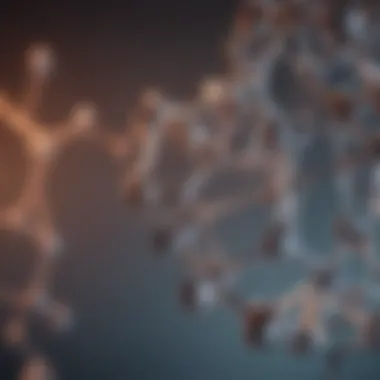Does Plastic Really Cause Cancer? Exploring the Evidence


Intro
The discourse surrounding plastic and its health implications has gained significant attention in recent years. As plastic becomes ubiquitous in daily life, concerns regarding its potential carcinogenic effects are paramount. Understanding the various types of plastics, their chemical compositions, and their relationship to human health is crucial for informed consumer behaviors.
Background and Context
Overview of the research topic
Research into plastic and cancer risk encompasses numerous studies that investigate how certain chemicals leach from plastics into food, liquids, and ultimately the human body. The major culprits include substances like bisphenol A (BPA), phthalates, and polystyrene. These compounds are often used to make plastics more durable or flexible but have raised alarms due to their similarities to hormones and their potential impact on cellular mechanisms.
Historical significance
The inquiry into the link between plastics and cancer is not new. In fact, studies investigating this connection date back several decades. The early research primarily focused on occupational hazards faced by workers in manufacturing settings. However, as plastic use expanded into households and consumer products, the scope of inquiry broadened to include everyday exposure.
Key Findings and Discussion
Major results of the study
The most notable findings indicate that prolonged exposure to specific plastics correlates with an increased risk of certain cancers. For instance:
- BPA exposure is linked to breast and prostate cancers in multiple animal studies.
- Phthalates have been shown to disrupt endocrine functions, potentially leading to hormone-related cancers.
- Styrene, used in producing polystyrene, is classified as a possible human carcinogen based on epidemiological data.
Detailed analysis of findings
The evidence largely stems from epidemiological studies, laboratory research, and toxicological assessments. These studies emphasize that the risk is not solely dependent on the plastic type but also on various factors such as exposure duration, temperature, and the presence of other chemicals in the environment. Furthermore, safety regulations have evolved in response to these findings, prompting some countries to restrict the use of harmful substances in plastics.
Despite the advancements in understanding the relationship, the results are still subject to debate. Some scientists argue that the risk posed by low-level exposure is negligible, while others insist that even minimal exposure over extended periods should not be taken lightly. The dispute underscores the need for ongoing research in this area to determine safe levels of exposure.
"Understanding the chemicals in plastics is vital for assessing their safety for human health. Many are deceptively common in everyday products, making awareness crucial."
Epilogue
Overall, while there is no unequivocal consensus on the carcinogenic effects of all types of plastics, current research suggests a growing body of evidence pointing to potential risks associated with specific compounds used in plastic production. Therefore, informed decision-making regarding plastic consumption and awareness of the materials in everyday items is essential. Moving forward, efforts should focus on enhancing research, advocating for stringent regulations, and promoting alternatives to hazardous plastics.
Preface to Plastic
The topic of plastic holds significant relevance today. It is interwoven into modern life, appearing in everyday items such as containers, toys, and packaging. The ubiquity of plastic raises concerns about safety and health, particularly regarding its potential link to cancer. Understanding plastic is crucial in assessing these health risks.
Plastics derive from various chemicals and undergo diverse manufacturing processes. Some of these substances can pose unknown hazards. A detailed examination of plastic types, their characteristics, and their associated chemicals forms the foundation of understanding cancer risks.
In this section, we will first define what plastic is. Next, we will explore common types of plastics. This exploration will clarify their properties and applications, which is essential for grasping how they might influence health outcomes.
Definition of Plastic
Plastic refers to a wide range of synthetic or semi-synthetic materials that can be molded into shape when soft and set into a rigid form. Plastics are made from polymers, long chains of molecules that typically contain carbon and hydrogen atoms. Their versatile nature allows them to be produced in various forms, including films, fibres, and solid objects.
To break it down further, the production process of plastic generally begins with fossil fuels. These hydrocarbons undergo chemical transformations to produce different resin forms, which can be further processed to create final products. Common examples of plastic include polyethylene, polystyrene, and polyvinyl chloride (PVC). Each type has distinct characteristics that make it suited for specific purposes.
Common Types of Plastics


Understanding the different types of plastics is essential in assessing potential health risks. Here are some prevalent types:
- Polyethylene (PE): Often used in bags and bottles, it's one of the most produced plastics globally.
- Polypropylene (PP): Common in food containers and automotive parts; it has good chemical resistance.
- Polystyrene (PS): Used in disposable cutlery and foam packaging, it is lightweight and rigid.
- Polyvinyl Chloride (PVC): Often found in pipes and medical equipment, it is versatile but can release harmful chemicals under certain conditions.
In summary, plastic is a complex product with various types, each posing different risks. Further exploration into their chemical compositions can illuminate their potential links to cancer, guiding our understanding and informed decisions on their usage.
Chemical Composition of Plastics
Understanding the chemical composition of plastics is crucial for grasping how these materials interact with the environment and human health. Plastics are made of long chains of polymers, which can be formed from natural or synthetic sources. These polymers can be manipulated to create various plastic products, each with distinct properties. More importantly, the chemical makeup of these materials often includes additives that can influence toxicity and health risks.
The specific chemicals used in plastic manufacturing, such as BPA and phthalates, warrant particular scrutiny due to their potential health implications. Knowing the composition of different plastics can inform safe usage practices, guide regulatory measures, and influence the development of safer alternative materials.
Polyethylene and Polypropylene
Polyethylene and polypropylene are among the most common types of plastics, often found in everyday products like bottles, containers, and shopping bags. Polyethylene is a simple polymer made from the polymerization of ethylene. It comes in various densities, including low-density polyethylene (LDPE) and high-density polyethylene (HDPE). Both forms have unique applications but are generally considered safe.
Polypropylene, on the other hand, is derived from propylene and has improved mechanical properties. It is often used in textiles, food packaging, and automotive parts. The safety of these plastics largely depends on their production methods and any additives used during manufacturing.
However, these materials can degrade over time and leach chemicals under specific conditions. Studies indicate that prolonged heating, particularly in microwaves, may cause these plastics to release potentially harmful substances into food.
Polyvinyl Chloride (PVC)
Polyvinyl chloride, commonly known as PVC, is another widely used plastic, particularly in construction and plumbing. Its chemical structure is more complex than polyethylene and polypropylene, often incorporating various additives to enhance durability and flexibility. These additives may include stabilizers, plasticizers, and other chemicals that can have health implications.
The main concern with PVC lies in certain chemicals used in its production, such as dioxins, which are known carcinogens. When PVC is burned or improperly disposed of, it can release harmful pollutants into the environment. As PVC ages, it can also degrade to release harmful chemicals, raising significant safety concerns. Regulatory bodies have thus imposed strict guidelines regarding the use and disposal of PVC products.
BPA and Phthalates
BPA (Bisphenol A) and phthalates are important plastic additives known for their endocrine-disrupting properties. BPA is frequently used in the production of polycarbonate plastics and epoxy resins. It mimics the body's hormones, leading to various health concerns, including reproductive issues and potential links to cancer.
Phthalates, often used to make plastics more flexible and durable, can also mimic hormones and have been associated with health problems such as asthma and developmental issues in children. Regulatory authorities are increasingly scrutinizing these substances, leading to bans in certain applications and advocating for safer alternatives.
Understanding Cancer
Understanding cancer is crucial in the context of examining plastics and their potential risks. Cancer, essentially, is a complex group of diseases that result from abnormal cell growth. These cells can invade surrounding tissues and spread to other parts of the body. Grasping the mechanics of cancer development can provide insights into how environmental factors, such as exposure to certain chemicals found in plastics, may influence cancer risk.
The mechanisms of cancer formation involve multiple steps, including initiating events that alter DNA, promoting changes that allow abnormal cells to proliferate, and possibly leading to invasive behavior. Chemicals can act as carcinogens by causing mutations or by promoting growth of initiated cells. Hence, understanding these processes is a key framework for evaluating the implications of plastic exposure on human health.
Cancer: Definition and Mechanisms
Cancer is not a single disease but a category of diseases that share a common characteristic: uncontrolled cell division. There are various types of cancer, each with its unique set of causes and risk factors. The basic mechanism involves the mutation of genes that regulate cell growth and division. These mutations can result from various factors, including genetic predisposition, lifestyle choices, and environmental exposures.
For instance, carcinogens can induce mutations in oncogenes or tumor suppressor genes, ultimately leading to tumor formation. The process often starts with an environmental exposure, which triggers a series of genetic alterations. Over time, cells may become cancerous through a combination of genetic, epigenetic, and environmental influences.
"Cancer is the ultimate outcome of complex interactions between numerous factors, where environmental exposures may play significant roles."
Types of Cancer Linked to Environmental Factors
Numerous studies have highlighted a connection between environmental factors and cancer risk. Certain types of cancer have been most frequently associated with exposure to damaging chemicals. Some common forms include:
- Lung Cancer: Often linked to pollutants in the air, including second-hand smoke and industrial emissions.
- Breast Cancer: Some research suggests links to environmental chemicals and hormonal disruptors, including those found in plastics.
- Prostate Cancer: Certain studies noted that its incidence might correlate with exposure to specific environmental toxins.
- Bladder Cancer: Linked to exposure to various industrial chemicals.


Understanding these associations is vital for assessing risk and guiding preventive measures. The presence of harmful contaminants in everyday materials, like plastics, necessitates further investigation.
Overall, comprehending the basics of cancer, its definitions, underlying mechanisms, and environmental factors offers vital context as we delve deeper into the discussion about plastics and their potential implications for health.
Scientific Studies on Plastic and Cancer Risk
The relationship between plastic exposure and cancer risk is complex and warrants thorough examination. Scientific studies play a pivotal role in this discourse as they provide empirical evidence regarding the health risks associated with various plastics. Understanding these studies helps us assess the veracity of claims linking plastic exposure to potential carcinogenic effects. By analyzing findings from different research approaches, we gain insights into how plastic components may affect human health and the potential mechanisms involved. Moreover, the implications of these studies serve both education and public health advocacy, ensuring individuals can make informed choices about plastic usage in their lives.
Animal Studies and Carcinogenic Effects
Animal studies are fundamental in evaluating the carcinogenic potential of plastic-related chemicals. These studies involve exposing laboratory animals, such as mice and rats, to specific plastic compounds, allowing researchers to observe any resulting tumors or health effects. For instance, studies have shown that chemicals like BPA and certain phthalates can increase tumor growth in rodents.
Such results raise alarms regarding similar effects in humans. However, results from animal studies cannot be directly translated to humans without caution, as the biological systems are different. Still, they pave the way for more extensive research and highlight the need for stringent safety assessments on plastic compounds.
"The results from animal experiments have often served as a precursor to human epidemiological studies, revealing a possible link that requires further investigation."
Epidemiological Studies in Humans
Epidemiological studies focus on patterns, causes, and effects of health and disease conditions in defined populations. In the context of plastic exposure, these studies investigate whether individuals regularly exposed to certain plastics show higher incidences of cancer. For example, research has observed connections between frequent usage of polyvinyl chloride (PVC) products and increased rates of certain cancers, such as liver and lung cancers.
A major strength of these studies is that they capture real-world exposure scenarios that animal studies cannot replicate entirely. However, they also face challenges, such as confounding variables, where other lifestyle factors might contribute to cancer risk. Despite these complexities, epidemiological evidence helps in assessing risks and guiding public health recommendations.
Review of Recent Meta-Analyses
Recent meta-analyses synthesize findings across multiple studies to draw broader conclusions. By examining data from various investigations, these reviews can identify consistent patterns regarding plastic exposure and cancer risk. Some analyses have pointed towards a significant association between certain plastic-related chemicals and increased cancer rates, motivating further regulatory scrutiny.
Meta-analyses help clarify conflicting results from previous research and provide a comprehensive overview of available evidence. However, the conclusions drawn often depend on the quality of included studies. Investigating the methodology and sample sizes is crucial in evaluating the validity of these conclusions.
In summary, scientific studies reveal important information about the potential carcinogenic risks associated with plastics. Each study type contributes uniquely to our understanding, ensuring a holistic picture emerges from the collective evidence. Ultimately, this information is vital for properly addressing public health concerns linked to plastic consumption.
Regulatory Perspectives
Understanding the regulatory landscape surrounding plastic use is essential in evaluating the potential health risks associated with its exposure. This section focuses on the legal frameworks and guidelines that govern the production and use of plastics, as well as the implications of these regulations for public health. Regulatory measures aim to minimize exposure to hazardous chemicals found in plastics and ultimately protect consumers. A strong regulatory perspective can lead to safer products and increased public confidence in plastic products. Additionally, knowing the regulations can empower individuals and organizations to make informed decisions about the plastics they use.
Global Regulations on Plastic Use
Globally, countries have instituted various regulations to control plastic use and limit exposure to harmful substances. Some notable international agreements include:
- REACH (Registration, Evaluation, Authorisation and Restriction of Chemicals): This regulation from the European Union seeks to manage the risks posed by chemicals, including those found in plastics.
- The Basel Convention: This international treaty focuses on reducing the movement of hazardous waste between countries and encourages environmentally sound management practices.
Different countries may have their specific regulations that reflect their unique environmental and health concerns. For instance, in the United States, the Environmental Protection Agency (EPA) regulates chemicals under the Toxic Substances Control Act, which includes oversight of some plastic materials.
"Regulatory measures aim to protect public health by ensuring that plastic products are safe for consumers and the environment."
It is important to note that regulations often evolve. Authorities continuously assess new research and adopt updated guidelines as the understanding of plastic's risks matures. Therefore, staying informed about these regulations is crucial for individuals and professionals alike.
Chemical Safety Assessments
Chemical safety assessments play a vital role in the regulatory landscape of plastics. These assessments evaluate the potential risks associated with the chemical components of plastic materials. By thorough evaluations, authorities can determine which substances require restrictions or bans. Key elements of chemical safety assessments include:
- Toxicological Profile: Evaluating how chemicals behave in biological systems and their possible toxic effects.
- Exposure Assessment: Understanding how people are exposed to chemicals in daily life, which helps prioritize which substances need regulation.
- Risk Characterization: Integrating data to understand the overall risk posed by the substances, which guides regulatory decisions.


Assessment outcomes inform policies and can lead to significant changes in the manufacturing process of plastics, reducing the presence of harmful substances like BPA and phthalates. Proper safety assessments ensure that plastics in consumer goods are not only effective but also as safe as possible for human health.
Preventing Exposure to Harmful Plastics
Understanding how to reduce exposure to harmful plastics is crucial, especially considering the ongoing debates about their potential health risks. Plastics are ubiquitous in daily life, and while they offer convenience, their safety concerns demand attention. Reducing exposure can lead to better health outcomes, particularly regarding the risk factors associated with various diseases, including cancer.
By adopting certain safe practices, individuals can significantly decrease their contact with harmful substances found in plastics and make informed choices about the materials they use.
Safe Practices for Plastic Use
- Choose Plastics Wisely: Opt for plastics labeled as "BPA-free". Polyethylene and polypropylene are generally considered safer choices. Avoid plastic products with recycling codes 3 or 7, as they may contain harmful chemicals.
- Avoid Heating Plastics: Refrain from microwaving food in plastic containers. Heat can cause chemicals to leach into food. Instead, transfer foods to glass or ceramic containers when reheating.
- Minimize Food Packaging Contact: Limit consumption of packaged and processed foods. Fresh foods often come with less plastic. When necessary, avoid plastic wraps; opt for wax paper or glass containers.
- Regularly Inspect and Replace: Old and damaged plastic items can leach more chemicals. Regularly check water bottles, containers, and toys for wear and tear. Replace them when necessary.
By implementing these safe practices, individuals can actively reduce their risk of harmful exposure while fostering a more health-conscious environment.
Alternative Materials to Plastics
The pursuit of alternatives to plastics is vital for long-term health and environmental benefits. The following materials can serve as substitutes:
- Glass: Durable and reusable, glass does not leach chemicals. It is ideal for food and beverage storage.
- Stainless Steel: Highly resistant to rust and corrosion, stainless steel is an excellent option for water bottles and food containers.
- Bamboo: Sustainable and biodegradable, bamboo products can replace many disposable plastic items.
- Natural Fibers: Cotton and hemp can substitute plastic bags and textiles, reducing plastic waste.
Exploring these alternatives not only reduces dependency on plastics but also fosters a more sustainable future. As awareness grows, the shift towards safer, more environmentally friendly materials becomes increasingly attainable.
Future Research Directions
The investigation into the relationship between plastic exposure and cancer risk remains a dynamic area of study. Ongoing research is crucial to elucidate the complexities of how various plastic constituents interact with biological systems. Future research directions not only seek to identify specific carcinogenic mechanisms but also aim to establish more effective safety guidelines based on the latest findings. One significant element of this effort involves scrutinizing the potential long-term impacts these chemicals could have on human health.
Emerging Chemicals of Concern
Recent studies have pinpointed several emerging chemicals found in plastics that could pose significant health risks. These include substances such as bisphenol S, a substitute for BPA, and the various types of phthalates utilized as plasticizers. While initial research suggests that these compounds may be less harmful than their predecessors, comprehensive studies are lacking.
- Bisphenol S (BPS): Studies indicate that BPS may disrupt endocrine functions, similar to BPA. However, its long-term carcinogenic potential is still unresolved.
- Phthalates: These chemicals have been linked to hormonal disruptions and are present in many household items. Research is needed to evaluate their cumulative effects on human health and potential links to cancer.
Continued scrutiny of these chemicals is vital. As awareness grows, so does the need for rigorous analysis of their toxicity and effects on various populations.
Long-term Studies on Human Health
Long-term studies are fundamental to understanding the chronic effects of plastic exposure on human health. Current epidemiological data often lacks the depth required to draw firm conclusions. Conducting longitudinal studies can help researchers observe health changes over time among populations exposed to specific plastics.
Key areas of exploration include:
- Cancer Incidence: Assessing rates of different cancer types in populations with high plastic exposure.
- Biomarker Research: Developing biomarkers to track exposure levels to plastics and their derivatives in human subjects.
- Vulnerable Populations: Studying the impacts on at-risk groups, such as children and pregnant women, can offer insights into heightened vulnerability.
In summary, ongoing and long-term research efforts are essential for a comprehensive understanding of how plastic exposure may influence cancer risk, considering emerging chemicals and prolonged exposure effects. By advancing this research, public health authorities and consumers alike can make informed decisions regarding plastic use, contributing to better health outcomes.
The End
The conclusion of this article encapsulates the critical insights derived from an analysis of plastic exposure and its potential link to cancer risk. Understanding the complexity of this relationship is paramount, not just for scientific inquiry, but for practical, everyday application in public health.
Summary of Findings
Research has illuminated several key points surrounding the relationship between plastics and cancer. Numerous studies highlighted hormones and chemicals, such as BPA and phthalates, in plastics, contributing to various health risks. Moreover, certain plastics, especially when heated, can leach harmful compounds. Animal studies indicate a potential carcinogenic effect. However, human epidemiological studies present mixed results, showing that the correlation between plastic exposure and cancer varies by type and extent of exposure. While some studies suggest a possible link to breast cancer, others fail to find decisive evidence. Overall, the interplay of environmental factors and individual susceptibility complicates the conclusions drawn.
Implications for Public Health
The implications of these findings for public health are profound. First, they emphasize the need for robust regulatory frameworks concerning chemical safety in plastics. Countries worldwide must reevaluate their standards and practices regarding material safety, pushing for more stringent regulations on the use of harmful substances. This is especially crucial for vulnerable populations, such as children and pregnant women, who might be at higher risk. Furthermore, public education campaigns are vital to inform consumers about safe practices when using plastics in daily life.
"Understanding the elements of plastic toxicity is essential for informed decision-making regarding consumption of plastic products."







